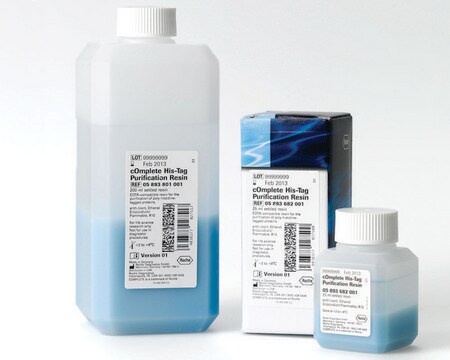推荐产品
應用
Acetyl-CoA carboxylase is responsible for synthesis of Malonyl-CoA which is an inhibitor of fatty acid oxidation in skeletal muscle mitochondria. The enzyme may be used to study the effect on production of malonyl-CoA as well as fatty acid oxidation during exercise. The enzyme also may be used for ACC regulation study in anti-obesity and anti-type 2 diabetes therapeutics.
生化/生理作用
Acetyl-CoA Carboxylase (ACC) regulates the metabolism of fatty acids. This enzyme catalzes the formation of Malonyl CoA through the irreversible carboxylation of acetyl CoA. There are two main isoforms of Acetyl-CoA carboxylase expressed in mammals, Acetyl-CoA carboxylase 1 (ACACA) and Acetyl-CoA carboxylase 2 (ACACB). ACACA has broad tissue distribution but is enriched in tissues critical for fatty acid sythesis such as adipose tissue. ACACB is enriched in tissues such as skeletal muscle and heart that are critical for fatty acid oxidation.
The Acetyl-CoA Carboxylase enzymes are activated by citrate, glutamate, and dicarboxylic acids and negatively regulated by long and short chain fatty acyl CoAs. Because of thier roles in fatty acid metabolism and oxidation, ACACA and ACACB are therapeutic targets for treating obesity and metabolic syndrome disorders.
The Acetyl-CoA Carboxylase enzymes are activated by citrate, glutamate, and dicarboxylic acids and negatively regulated by long and short chain fatty acyl CoAs. Because of thier roles in fatty acid metabolism and oxidation, ACACA and ACACB are therapeutic targets for treating obesity and metabolic syndrome disorders.
物理性質
C-terminal HIS-tagged 277 kDa full length protein
單位定義
One unit will cause the carboxylation of 1 picomole of acetyl-CoA per minute at pH 7.4 at 30 deg C.
外觀
Buffered aqueous solution containing Tris-HCl, pH 8.0, NaCl, glycerol, and DTT. May also contain one or more of the following: EDTA, KCl, imidazole, TWEEN-20.
準備報告
Thaw on ice. Upon first thaw, briefly spin tube containing enzyme to recover full content of the tube. Aliquot enzyme into single use aliquots. Store remaining undiluted enzyme in aliquots at -70°C. Note: Enzyme is very sensitive to freeze/thaw cycles.
儲存類別代碼
12 - Non Combustible Liquids
水污染物質分類(WGK)
WGK 1
閃點(°F)
Not applicable
閃點(°C)
Not applicable
W W Winder et al.
The American journal of physiology, 270(2 Pt 1), E299-E304 (1996-02-01)
Malonyl-CoA, an inhibitor of fatty acid oxidation in skeletal muscle mitochondria, decreases in rat skeletal muscle during exercise or in response to electrical stimulation. Regulation of rat skeletal muscle acetyl-CoA carboxylase (ACC), the enzyme that synthesizes malonyl-CoA, was studied in
Jorgen F P Wojtaszewski et al.
American journal of physiology. Endocrinology and metabolism, 284(4), E813-E822 (2002-12-19)
The metabolic role of 5'AMP-activated protein kinase (AMPK) in regulation of skeletal muscle metabolism in humans is unresolved. We measured isoform-specific AMPK activity and beta-acetyl-CoA carboxylase (ACCbeta) Ser(221) phosphorylation and substrate balance in skeletal muscle of eight athletes at rest
Lutfi Abu-Elheiga et al.
Proceedings of the National Academy of Sciences of the United States of America, 100(18), 10207-10212 (2003-08-16)
Malonyl-CoA, generated by acetyl-CoA carboxylases ACC1 and ACC2, is a key metabolite in the control of fatty acid synthesis and oxidation in response to dietary changes. ACC2 is associated to the mitochondria, and Acc2-/- mice have a normal lifespan and
Philip D Bates et al.
Proceedings of the National Academy of Sciences of the United States of America, 111(3), 1204-1209 (2014-01-09)
Degradation of unusual fatty acids through β-oxidation within transgenic plants has long been hypothesized as a major factor limiting the production of industrially useful unusual fatty acids in seed oils. Arabidopsis seeds expressing the castor fatty acid hydroxylase accumulate hydroxylated
Graeme J Gowans et al.
Cell metabolism, 18(4), 556-566 (2013-10-08)
While allosteric activation of AMPK is triggered only by AMP, binding of both ADP and AMP has been reported to promote phosphorylation and inhibit dephosphorylation at Thr172. Because cellular concentrations of ADP and ATP are higher than AMP, it has
我们的科学家团队拥有各种研究领域经验,包括生命科学、材料科学、化学合成、色谱、分析及许多其他领域.
联系技术服务部门







